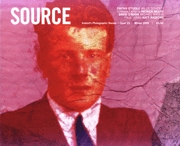Perfidious Nature
Vanitas - Vanitae by Javier de la Garza was at Triskel Arts Centre, 8 Sept - 12 Oct 2000
Review by Nora Donnelly
Issue 25 Winter 2000
View Contents ▸
While each of de la Garza's ten enormous photographs speaks in its own voice - of itself and by itself - and tells its own story in its own way, there is an on-going narrative which is disclosed as the spectator moves from the first to the final piece in this show. Each individual image may exist independently, the meaning self-referential and self-contained, but as the correspondence is effected between one and the others there are added tensions, added forces, added layers. These demand the forging of conceptual/imaginative links where meaning is augmented and strengthened.
This is a deliberate ploy on de la Garza's part which ensures not only the unity of the show (with a single - and singular - theme) but also means that the bond between subject and object (spectator and image) is made and tightened in such a way as to overcome any distance between them. That is to say that the spectator is, on one level, absorbed in the single representation while drawn and pushed to make connections in a reflective process which transcends physicallactual boundaries. Further in the conceptual interplay of these images - at once apposite and opposite - a number of forces/tensions arise. For example, the celebratory is tinged by lamentation; conceit hovers at the point of raw humiliation; what is revealed is only revealed by concealment; candour is cloaked in disingenuous dissimulation; ardour struggles with apathy. Whereas meaning initially seeps through the tiny passage between these counter forces, it gathers momentum forcefully.
How does this happen? Well, to begin with, there are the photographs themselves. Enlarged to such an extent pointillistic break- up/fusion of the image occurs, they simultaneously present and represent an immanence of figure/ground which introduces a quality of unreality - or more correctly, another, or alternative reality. ln the process fragmentation alters the perception. What you thought was there may not be; what is there may not be what you thought it was - or is it? Bewildered, you are thrown back on yourself.
Then there is the diversity in range of view-points, transpositionally altering scale. Here a close up augments the diminutive; there a distance shot removes the proximate to remote space. Sequentially, you're thrown off balance. The sense of being pulled towards the image and quicklythrust away from it is reflected in the'push me - pull you' response to what the images themselves signify. The truism that the object of desrre attracts while the repugnant repels means here that we rush rmpetuously forward but are driven rapidly back in a formalised pattern. This motion and counter-motion makes us participants in a curious form of dance (advance, retire and dos-à-dos), which in this case is the dance of life.
A world where the packaging reflects the value of the goods, where 'the slim and fit are fun to be with', there is an addictive concern with appearance that contains within itself the seeds of its own destruction. The bright and shiny 'hard-body' culture has a malevolent dark side. Nature is perfidious. lt lets us down. lt lets us down badly. We age and the quiver of desire all too soon becomes the shudder of distaste.
Ken (Barbie-doll's dolly partner) is metamorphosed before our very eyes. His lithe plastic body deteriorates. He becomes a flabby Mister Blobby type figure. His lover grows and grows. He grows pinker. He grows more bloated. He grows pendulous breasts. He grows more eager for (and more grateful for) sex.
The relationship between the key players (coupling couples) may well decline from early triumphant eroticism to the blather and bluff of shabby salaciousness, but in de la Garza's treatment of them both figures somehow transcend hackneyed stereotypes. Objective candour and personalised sympathy exist in rare harmony. He hits just the right note. The lyricalism of homosexual love sings too sweetly, too resonantly and too strongly to be discounted as mere affected swagger on one hand or trivialised as grotesque absurdity on the other. Yes, the show may glance towards semblances of parody, but its look penetrates. De la Garza's work reveals and discloses deeper truths, new realities that acknowledge and embrace perfidious nature.
Other articles by Nora Donnelly:






